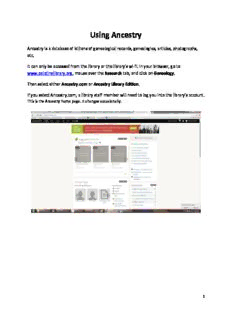Table Of ContentUsing Ancestry
Ancestry is a database of billions of genealogical records, genealogies, articles, photographs,
etc.
It can only be accessed from the library or the library’s wi-fi. In your browser, go to
www.palatinelibrary.org, mouse over the Research tab, and click on Genealogy.
Then select either Ancestry.com or Ancestry Library Edition.
If you select Ancestry.com, a library staff member will need to log you into the library’s account.
This is the Ancestry home page. It changes occasionally.
1
Ancestry Library Edition (ALE) is a version of the subscription Ancestry.com with some of the
features and functionality removed. It has fewer databases, but still contains most of the vital
records most researchers need.
Ancestry Library Edition (ALE) is the institutional version of the subscription Ancestry.com
available in many libraries. They are similar but ALE has some of the features and functionality
removed. It has fewer databases, but still contains most of the vital records most researchers
commonly need.
What’s the difference between Ancestry.com and Ancestry Library Edition?
Here is a gnereal list of the main differences
Ancestry.com has a lot of personalized functionality.
There is marketing information on Ancestry.com
There are additional tabs on Ancestry.
• Trees Tab - Upload photos, documents and add stories about ancestors into
Personal and Public Member Trees.
• DNA Tab – Information related to your AncestryDNA test
• Help Tab – Link to Support Center, Message Boards, and other aides.
• Extras Tab – Items and services for purchase
Additionally, there are certain databases that are available on Ancestry.com, that are
NOT available on Ancestry Library Edition (ALE):
• Historical Newspaper Collection
• Family and Local History Collection
• Obituary Collection
• Periodical Source Index (PERSI)
• Filby's Passenger and Immigration Lists Index (PLI)
• Biography & Genealogy Master Index (BGMI)
• Freedman’s Bank Records
2
Ancestry Library Edition Tabs
The basic ALE home page. It also changes occasionally.
Navigation Tabs
3
Ancestry’s records are divided into collections of related records. For example the 1940 United
States Federal Census is a collection. Collections are organized into categories. The 1940 United
States Federal Census collection is part of the Census and Voter Lists category. Other categories
include Birth, Marriage & Death and Military. The categories are listed to left of the search
results page. Some of the categories can be seen in the Search tab drop-down menu.
There are over 10,000 collections in ALE. (by contrast, Ancestry .com has over 32,000!) To list
them, mouse over the Search tab and click on Card Catalog.
4
Which yields the list of collections
The sorting criteria
Database title and
keyword search boxes
Note the different filters
to narrow the list.
Number of
records in the
collection
Number of collections
within the category
Note the filters to the left of the screen. Users can filter by category (notice that it reads
“collection” here), or by location (United States, Europe, etc.), dates or by language. The
number that follows each category is the number of collections in the category.
The collections are initially sorted by popularity (number of times accessed). They can also be
sorted by Title, Record Count, Date Added or Date updated.
The title, collection (category), and the number of records display for each collection.
Can also search for a database either by name or keyword.
Selecting a specific collection allows the user to limit the results by searching only that
collection.
5
Click Search tab yields this page:
In addition to the four basic search fields, dates of life events (birth, marriage, death, etc.),
family members (mother, father, spouse, children) can be added to the search criteria.
Searches can be limited by geographic location (state, country, or area). This means only
collections from the selected area will be searched. Only one location can be selected at a time.
The right hand column has quick links to some specific collections.
6
Clicking on Message Boards takes you to the screen below.
A message board is a good way to connect and share information with other Ancestry users. Users can
search through the boards to find solutions to research problems faced by other users.
Be careful though, the people posting on these boards aren’t necessarily experts and may make
mistakes!
Note: ALE users can read posts on any of the boards, but may not post. Users can create a free account
and post from Ancestry.com. Those posts can then be read on ALE.
7
The Learning Center is a great resource of helpful information and research tips.
Clicked on
Explore and then
on article title in
Immigration
Records to get
the article below.
Here you will find articles on how to use Ancestry, getting started with genealogical research and more.
The Charts and Forms tab includes (maybe) useful research tools.
These tools include blank census forms for US, Canada and the UK and ancestral charts
8
Links to blank
census forms
Some of other forms from the U.S.
might useful in some Canada, and the
cases U.K.
Blank census forms are handy to have when scanned census record headings are hard to read.
Sometime useful for older census records (prior to 1920 census) that don’t have the
highlighting feature.
New Collections is a list of the recently added collections.
The page layout and filtering options are identical to the Card Catalog option of the Search tab.
9
Searching!
The basic search page.
Four basic search fields: First Name/Middle Nane, Last Name, Location (anywhere the ancestor
had lived, born, died, etc.), and year of birth. Use the Calculator if you know the age of the
ancestor on a given year.
10
Description:Biography & Genealogy Master Index (BGMI). • Freedman's Bank States Federal Census collection is part of the Census and Voter Lists category.

